
Browse an alphabetical list of photographs. These historical images portray people, places, and events before, during, and after World War II and the Holocaust.
<< Previous | Displaying results 2326-2350 of 2641 for "Photo" | Next >>
View of the courtroom as seen from the interpreters' section during the IG Farben Trial. The defense lawyers are in the foreground, the defendants are in the dock to the right, and the spectators' gallery is on the far side of the courtroom.
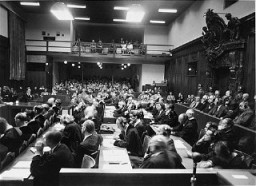
View of the courtroom during the trial of John Demjanjuk. Chief defense counsel Mark J. O'Connor addresses the court during the first session of the trial. Jerusalem, Israel, February 16, 1987.
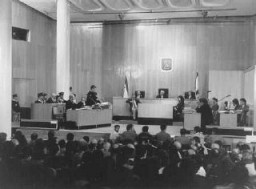
The courtroom in the Palace of Justice, chosen as the location for the International Military Tribunal trial of war criminals. This photograph shows the courtroom before any repairs or alterations were made. Nuremberg, Germany, August-September 1945.
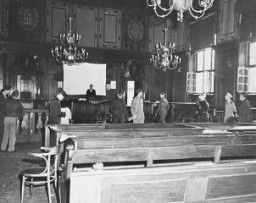
Karl Höcker's photograph album includes both documentation of official visits and ceremonies at Auschwitz as well as more personal photographs depicting the many social activities that he and other members of the Auschwitz camp staff enjoyed.
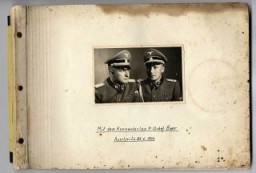
The Danish Freedom Council, Denmark's unofficial government-in-exile from July 1944 to May 1945, was made up of leaders of the four main resistance groups. London, Great Britain, between July 1944 and May 1945.
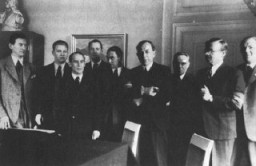
The defendants' box at the Nuremberg trial. Hermann Göring is seated at the far left of the first row. Nuremberg, Germany, 1945-1946.
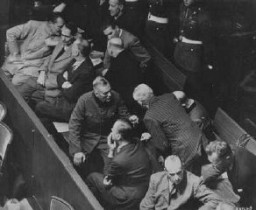
The defendants' dock and members of the defense counsel during the Doctors Trial. Nuremberg, Germany, December 9, 1946–August 20, 1947.
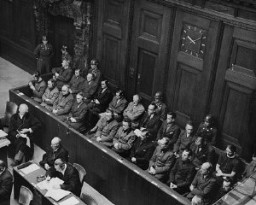
The defendants in the dock during the Justice Case, Case #3 of the Subsequent Nuremberg Proceedings. Nuremberg, Germany, 1947.
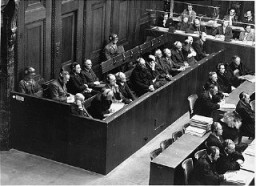
The defendants in the dock (at rear, with headphones) and their lawyers (front) follow the proceedings of the Hostage Case, case #7 of the Subsequent Nuremberg Proceedings. Nuremberg, Germany, 1947-48.

This multistory complex served as the Drancy transit camp. The overwhelming majority of Jews deported from France were held here prior to their deportation. Drancy, France, 1941–44.
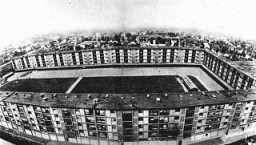
View of the entrance to the "Gypsy camp" on Brzezinska Street in the Lodz ghetto in occupied Poland. Photograph taken in 1942.
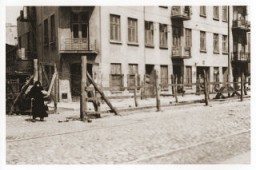
The Evian Conference on Jewish refugees. From left to right are French delegate Henri Berenger, United States delegate Myron Taylor, and British delegate Lord Winterton. France, July 8, 1938.
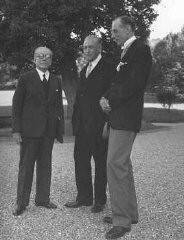
The extended Derman family. Top row, left to right: Aron, Lisa, Howard, Miriam, Daniel, Ari, Gordon, and Barbara (Howie's wife). Front row, left to right: Rachel, Yali, Evan, Gabe, Courtney, Ben, and Lindsay.
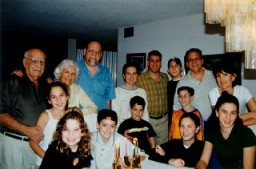
Michael Fink and his parents Manfred and Herta in the Westerbork camp, 1941–1944. Westerbork's primary role was as a transit camp. However, there was also a long-term camp population there. The Finks were among these residents. The family was in Westerbork until the spring of 1944, when they were deported to Theresienstadt. Michael and Herta survived, but Manfred was killed after being deported to Auschwitz-Birkenau and other concentration camps.
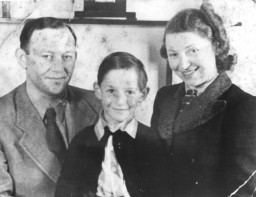
The Reichstag (German parliament) building burns in Berlin. Hitler used the event to convince President Hindenburg to declare a state of emergency, suspending important constitutional safeguards. Germany, February 27, 1933.
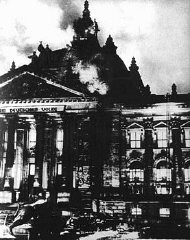
The “Gypsy camp” in Hodonín u Kunštátu (Hodonin bei Kunstadt), Protectorate of Bohemia and Moravia (Czech Republic), 1942.
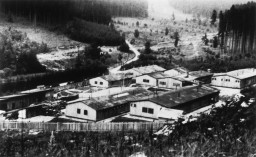
The Institute for Sexual Science was founded in Germany by Dr. Magnus Hirschfeld, a leading researcher of sex, sexuality, and gender. In 1933, the Nazis looted the institute and forced it to close. Photo published in 1924.
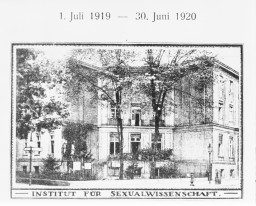
American judges (top row, seated) during the Doctors Trial, case #1 of the Subsequent Nuremberg Proceedings. Presiding Judge Walter B. Beals is seated second from the left. Nuremberg, Germany, December 9, 1946–August 20, 1947.
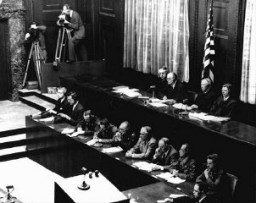
Exterior view of the Jewish orphanage run by Janusz Korczak. Established in 1912, the orphanage was located at 92 Krochmalna Street in Warsaw, Poland. Photo taken circa 1935.
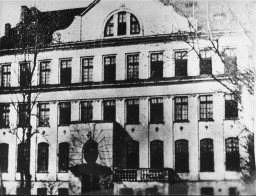
The Ku Klux Klan marches down Pennsylvania Ave in Washington, DC. Photograph by Harris & Ewing, 1926.

The Kusserow family was active in their region distributing religious literature and teaching Bible study classes in their home. They were Jehovah's Witnesses. Their house was conveniently situated for fellow Jehovah's Witnesses along the tram route connecting the cities of Paderborn and Detmold. For the first three years after the Nazis came to power, the Kusserows endured moderate persecution by local Gestapo agents, who often came to search their home for religious materials. In 1936, Nazi police…
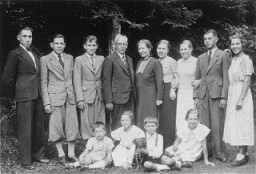
The Kusserow family home in Bad Lippspringe. The family, Jehovah's Witnesses, kept religious materials in the trunk of the car and distributed them from it as well. The Kusserow family was active in their region distributing religious literature and teaching Bible study classes in their home. Their house was conveniently situated for fellow Witnesses along the tram route connecting the cities of Paderborn and Detmold. For the first three years after the Nazis came to power, the Kusserows endured moderate…
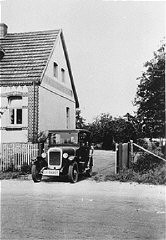
This photograph shows the Kusserow family home in Bad Lippspringe and the tram tracks in front of it. The Kusserow family members were active Jehovah's Witnesses in their region. They distributed religious literature and taught Bible study classes in their home. Their house was conveniently situated for fellow Witnesses along the tram route connecting the cities of Paderborn and Detmold. For the first three years after the Nazis came to power, the Kusserows endured moderate persecution by local Gestapo…
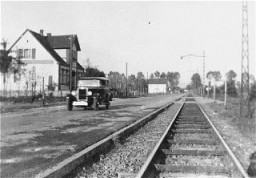
The main gate of the Wöbbelin concentration camp. On May 2, 1945, the 8th Infantry Division and the 82nd Airborne Division encountered the Wöbbelin concentration camp. Photograph taken upon the liberation of the camp by US forces. Germany, May 4, 1945.
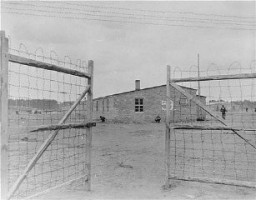
The Margules children wearing Jewish badges. Originally from Warsaw, the Margules family settled in Paris in the 1930s. Three of the children were deported and killed in 1942. Only one daughter (pictured at the bottom right) survived the war. Paris, France, 1941.
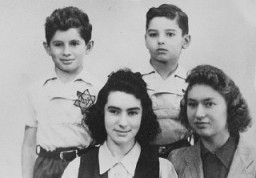
We would like to thank Crown Family Philanthropies, Abe and Ida Cooper Foundation, the Claims Conference, EVZ, and BMF for supporting the ongoing work to create content and resources for the Holocaust Encyclopedia. View the list of donor acknowledgement.